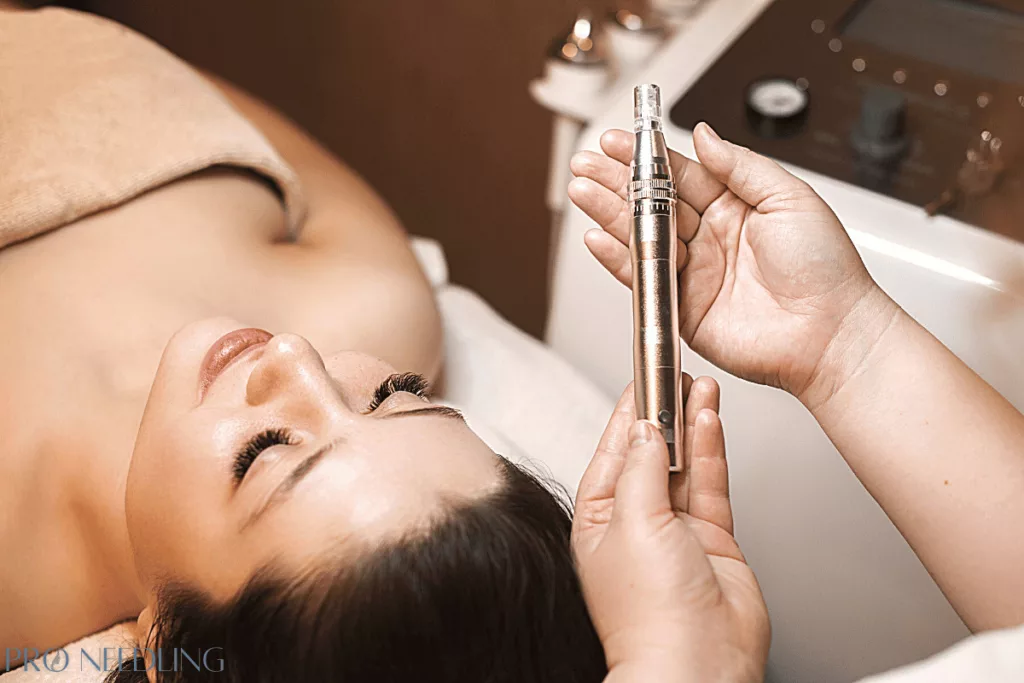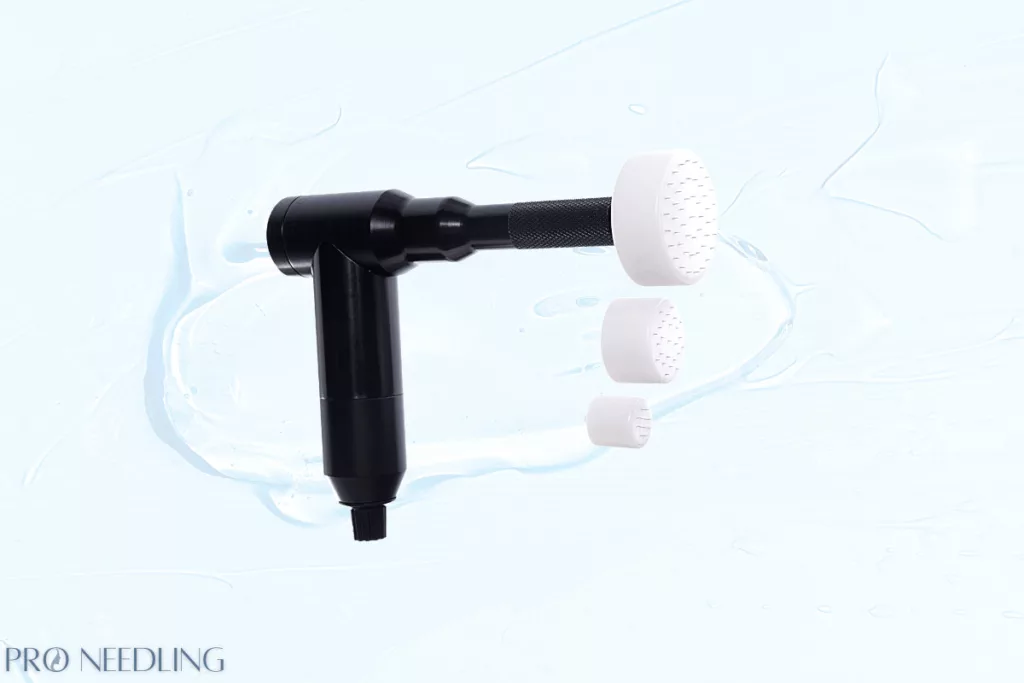Microchanneling and microneedling are both popular skin rejuvenation and noninvasive treatments used to improve various skin concerns such as dry skin, acne scars, stretch marks, sun spots, and visible pores. Both treatments are forms of skin needling to produce new collagen production and unlock anti-aging benefits. Below we compare microchanneling vs microneedling treatments, pointing out their main differences and how they work. While no treatment can be deemed definitively more effective, results will vary due to the individuality of each person’s unique skin type and concern treated.

Editor’s Note:
Although these devices/treatments are accessible for personal use at home, we strongly advise seeking treatments under the supervision of a qualified dermatologist or trusted skincare professional.
Microchanneling vs Microneedling Comparison
Microchanneling and microneedling are both minimally invasive skin rejuvenation treatments that use tiny needles to create controlled micro-injuries in the skin. Both treatments share a common purpose and benefit, utilizing needles to activate the body’s natural healing process, encouraging skin cell renewal, and promoting overall skin health.
However, there are some key differences between these two procedures, primarily their technique and tools used to administer treatment.
Purpose
The purpose of microneedling and microchanneling treatments is to rejuvenate the skin and address various skin concerns through controlled micro-injuries. Both treatments stimulate the body’s natural inflammatory healing process, resulting in improved skin texture, tone, and overall appearance.
These treatments share two mutual benefits:
- Promote collagen and elastin production for skin rejuvenation
- Enhancing product absorption for the delivery of potent skincare ingredients
However, they achieve their goals through different techniques and target different aspects of skin health. The choice between these treatments depends on individual skin concerns and desired outcomes, and both can be effective tools for achieving healthier skin.
Both treatments are suitable for most areas of the face and body. It is commonly used for treating signs of aging such as fine lines, wrinkles, uneven skin texture, rosacea, hyperpigmentation, acne scarring, and stretch marks.
It’s crucial to consult with a dermatologist or skincare professional to determine which treatment is best suited for specific skin needs.
Technique & Devices
Microchanneling and Microneedling differ primarily in their techniques and the devices employed during the treatment process.
Microneedling: Microneedling treatments use devices called microneedling pens or derma rollers. Pens are electric devices that automatically and precisely create punctures by oscillating needles up and down. Dermarollers are manual devices that consist of a cylindrical roller with numerous fine needles attached to it, meant to roll or glide over the surface of the skin.

Microchanneling: Microchanneling is performed using a specialized stamp-like device, which is equipped with fine, vibrating needles. These needles create microchannels in a more precise and linear stamping technique. This controlled formation allows fewer chances of skin damage and discomfort when compared to traditional rollers.
Depth of Penetration
Microneedling treatments, known as collagen induction therapy, are generally used to reach deeper layers of the skin, including the dermis. A microchanneling treatment generally operates at a shallower depth, mainly targeting the upper dermal layers. The difference in depth of penetration makes each treatment suitable for different skin concerns and goals.
Microneedling: Microneedling pens offer more controlled and precise needle application due to their automated oscillation when compared to rollers. Dermarollers rely on manual rolling techniques, which can be effective when used carefully but may require more skill and practice to ensure consistent results.
- Needle lengths vary between .2mm and 2mm
- Typically reaches the dermis, the second layer of the skin.
Microchanneling: Microchanneling usually operates at a more consistent and shallower depth, targeting the upper layers of the dermis. The devices typically use needles with varying lengths, but they are generally shorter or tinier than the needles used in traditional microneedling procedures.
- Needle lengths range from .5 millimeters to around 1.5 millimeters
- Primarily targeting the epidermis and the upper dermis
Treatment Process
Both treatments start with skin preparation, making sure the area is properly cleaned. The next step involves the creation of controlled micro-injuries, and utilizing nutrient serums for enhanced results. Both treatments call for specific serums or products based on the individual’s skin needs.
Nutrient topical serums can include epidermal growth factors, stem cells, platelet-rich plasma (PRP), or hyaluronic acid. Aftercare routines for both treatments emphasize skin hydration, protection, and cleanliness to ensure the best possible outcome.
Side Effects & Downtime

Both treatments can result in some form of skin irritation, specifically for individuals with sensitive skin.
Potential side effects of both treatments may include:
- Bruising
- Dryness/Flaking
- Mild Discomfort
- Redness/Irritation
- Swelling
Due to its ability to reach deeper layers of the skin, microneedling may cause slightly more discomfort during the procedure. Downtime can vary, with redness and mild irritation lasting for a few days, generally no more than 24 to 48 hours. Due to these longer and more invasive needles, there is a higher risk to cause damage to dermal cells from inexperienced users.
Microchanneling can generally be a more comfortable procedure, with minimal downtime of just a few hours to a day or two. The downtime is minimal due to the precise method of the microchannels, which also provides a lower risk of inflammation.
Which Treatment Is Better?
Both treatments lack a definitive superiority, as the choice of an appropriate skincare procedure hinges on the distinctive characteristics of an individual’s skin and the particular condition they seek to address. Issues such as stretch marks, burns, and scars generally reside deeper within the skin and therefore would be more suitable to treat with microneedling.
The choice between these treatments depends on individual skin concerns and desired outcomes, and both can be effective tools in achieving healthier, more youthful-looking skin. It’s crucial to consult with a dermatologist or skincare professional to determine which treatment is best suited for specific skin needs.
Summary
In summary, while both microneedling and microchanneling involve creating micro-injuries in the skin to stimulate collagen production, they have distinct differences in technique, depth, and devices used. The choice between the two treatments depends on individual skin concerns and the desired results, which are best determined through a consultation with a qualified skincare professional.

1 thought on “Microchanneling vs Microneedling: Which Is Better?”